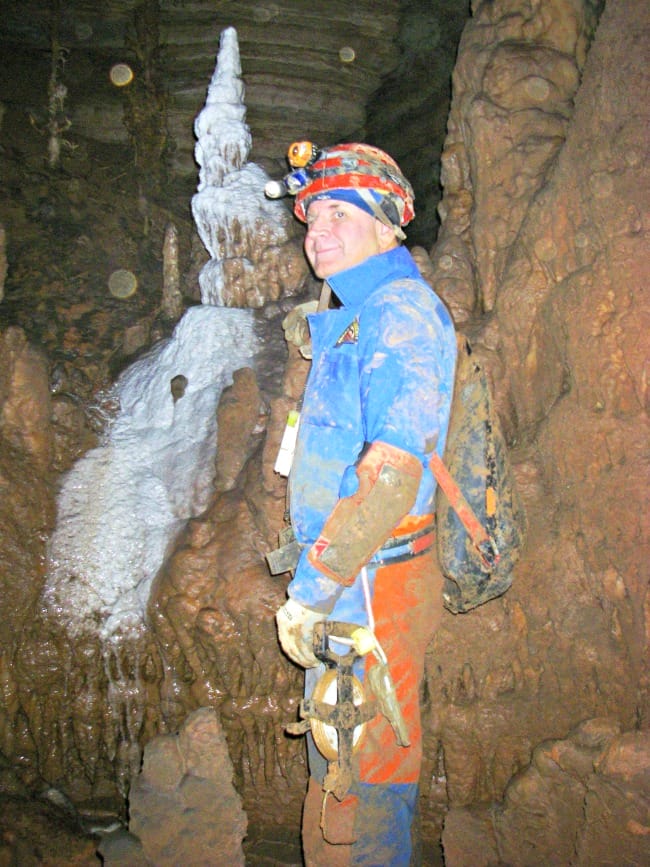

Uh oh...
It appears that you're using a severely outdated version of Safari on Windows. Many features won't work correctly, and functionality can't be guaranteed. Please try viewing this website in Edge, Mozilla, Chrome, or another modern browser. Sorry for any inconvenience this may have caused!
Read More about this safari issue.

If you’ve roamed Arkansas state parks, trails or back country long enough, you’ve likely come across a cave or two. Northern Arkansas is home to over 2,000 documented caves beneath the Ozark Mountains and Buffalo River Valley. With a little knowledge and planning, you can visit some of Arkansas’s unique landscapes deep under the earth.
Arkansas has a number of “show caves” that offer public tours to display the wonders of Arkansas underground. These are living caves containing stalactites and stalagmites formed by minerals deposited by water seeping through the ground. Be sure to wear a jacket, sturdy shoes, and plan on a muddy, wet environment for your visit. Some of Arkansas’s show caves are Blanchard Springs Caverns, Bull Shoals Caverns, Cosmic Caverns, Mystic Caverns, Onyx Cave, Old Spanish Treasure Cave and War Eagle Cavern.

Some show caves also offer guided “wild caving” tours that allow visitors to venture away from the lighted walking paths into less accessible passages that require crawling, mild climbing or scrambling, and squeezing through tight spots. Cave operators usually provide helmets, lights, and other personal safety gear such as gloves and kneepads as part of their wild tour package.
If you’re the more adventurous type and you’d like a closer look at Arkansas’s caves, joining an Arkansas Grotto is the way to go. Grottos are regional caving clubs associated with the National Speleological Society (NSS) that are committed to cave conservation, education and safety. The NSS has five Grottos in Arkansas that meet on a regular basis. Grottos offer training on safe caving techniques and equipment and organize trips to caves not accessible to the general public.

Safety is one key reason anyone interested in caving should participate in a local grotto. Caves are often wet, muddy and, of course, dark. The terrain inside caves is uneven, rough and rocky. It frequently requires stooping, crawling, and climbing up and down steep and hazardous slopes. There can be vertical pits and exposed ledges which present falling hazards. Experienced cavers use climbing ropes and other special equipment and techniques to safely negotiate these cave passages.
Walking into a cave unprepared is asking for disaster. Former Boston Mountain Grotto president Terry Mitchell speaks of several cave rescues when hikers exploring Devil’s Den cave in the state park became stuck or injured. These rescues spurred the Boston Mountain Grotto to survey and map Devil’s Den Cave so search and rescue teams could be better prepared for future rescues. That cave and many others on state and federal lands are currently closed to the public because of the spread of White Nose Syndrome (WNS) in the bat population. Entering closed caves is against the law and can result in massive fines to the violators.

The NSS and Arkansas Grottos emphasize responsible caving. Cavers decontaminate their equipment and clothing according to a strict protocol after each trip to curtail the spread of WNS. The Grottos also maintain good relationships with landowners where private caves are located. Many of these caves are gated for safety and require landowner permission to enter. Cavers strive not to damage any of the cave environment or its inhabitants and pack out everything they take into a cave (especially human waste). It is illegal to damage or remove speleothems (mineral deposits like stalagmites), archeological items found in caves, or any cave life. If you’re caving in Arkansas, you might encounter bats, spiders, crickets, beetles, salamanders and cavefish. Though not cave dwellers, bears and snakes can sometimes be present inside a cave entrance, so cavers should use caution at all times.

One NSS caving safety mandate is to carry three sources of light on you at all times, including a headlamp attached to a sturdy helmet. Another rule of thumb is to wear gloves, kneepads and appropriate clothing. Caves maintain a constant temperature year round and Arkansas caves range from the upper 50s to low 60s. That might sound appealing on a hot summer day, but caving typically involves crawling, mud and water. If you’re not properly dressed, it’s easy for hypothermia to set in. To be prepared for possible mishaps or delays, all cavers should carry water, food, first aid kits, extra batteries, and other emergency items in a caving pack.
Perhaps the most important rule for caving is to never enter a cave alone. The NSS recommends a minimum of four people in a group led by an experienced grotto member. Though the idea of spending hours underground can sound daunting, Terry Mitchell emphasizes the adventurous spirit and camaraderie caving produces. After caving trips, grotto members often tell caving stories and share information around the campfire. “The underground world is one of the last frontiers on earth for such adventures,” Mitchell says.

If you’re not afraid of a little mud, and you’re ready to try caving, check out the resources below and enjoy Arkansas in a way you’ve never seen it before.
Arkansas Grottos
Boston Mountain Grotto – Springdale
Central Region Arkansas Grotto – Harrison
COBRA Grotto – Batesville
Little Rock Grotto
Middle Ozark Lower Earth Society (MOLES) – Maumelle
National Caving Links
National Speleological Society
White Nose Syndrome and Decontamination Procedures
Cave Safety
Photos by Terry Mitchell and used with permission.
Join the Conversation
Leave a Comment
2 responses to “Arkansas Caves: Adventures Underground”
 Leave a Reply
Leave a Reply
We do the work.
You check your email.
Sign up for our weekly e-news.
Get stories sent straight to your inbox!










 Leave a Reply
Leave a Reply
[…] Caves aren’t the only place you’ll find bats roosting during the day. They can also be found in trees, barns, and other man-made structures. Most bats awaken around twilight to feed and return to their roosts by dawn. Bats live in groups called colonies that can number into the thousands or even millions. Since bats play such a vital role in our ecosystem, maintaining thriving colonies of bats is important. You can make the area around your home more inviting by constructing a bat box and limiting or eliminating the use of pesticides. And of course, when you see a bat busily chasing insects on a warm Arkansas evening, thank it for its hard work and enjoy the acrobatics of an amazing mammal. […]
[…] few years ago, OnlyinArk writer Kimberly Mitchell shared about these incredible underground adventures along with a wealth of safety tips and information on “wild caving” and how to join caving […]